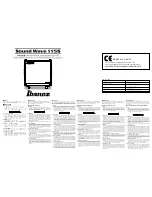
AMI Analyzer Manual
Installation Procedure
10
Operation
Analyzer operation
It is just as important that the analyzer’s sample system – the components used to
control the gas flow – are perfect as the measurement methodology itself. No matter how
good the analyzer is, if you don’t connect the plumbing correctly you won’t get good
results.
Sample tubing and components
Oxygen diffuses through plastics, to a greater or lesser extent. Standard blue poly tubing
will diffuse about 1ppm per foot into 1SCFH at 70°F. Silicone tubing is very much worse.
In general, use stainless steel tubing, or at least copper tubing, not plastic. Use high
quality compression fittings such as “Swagelock™” or “Gyrolock™” and high quality
stainless steel filters, valves or regulators if necessary. Make sure that they are
assembled correctly and perform a thorough leak test on the sample system before use.
The analyzer expects to see sample pressures between about 1 psig and 100psig. Higher
pressures will make the flow control valve very touchy. If your pressure is higher than
this use a regulator with a stainless steel diaphragm to bring the pressure down
appropriately. The analyzer is not very much affected by changes in flow rate and the
internal flow meter is adequate for setting the flow. Don’t use a high precision external
flowmeter in front of the analyzer because oxygen will diffuse in through its O rings.
The span gas pressure should also be held below 100psig. If you permanently connect a
span gas tank to it via a user-supplied three way valve, make very sure that the
connection is leak tight as otherwise not only will the calibration be in error but also you
will lose all of your span gas as it leaks out.
Leaks
If you suspect a leak due to high oxygen readings, change the flow rate and see how long
it takes for the oxygen reading to change. A higher flow rate will dilute the effects of a
leak so that the reading will drop as you increase the flow (this is a very good way of
making sure that you do not in fact have a leak, by the way). Turn the flow up from 1
SCFH to 2 SCFH using the front panel valve and see how long it is before the reading
changes. If it does so immediately, the leak is close to the analyzer. If it takes longer, the
leak is further away.
Exhaust
The exhaust port of the analyzer should be given at least a foot of tubing, but it should
not be allowed to become pressurized, or the readings will be affected. If the sample gas
is innocuous, such as pure nitrogen, it can be vented into the room with no ill effects, if
the room itself is ventilated. Otherwise it should be vented outdoors or brought into a
scavenging system. If the latter, have the scavenging system suck in room air around the
exhaust line so that the pressure at the exhaust is atmospheric. A typical way of doing
this is to have the scavenging system suck on a 1” pipe, and have the ¼” exhaust line
from the analyzer extend six inches or so into the end of the pipe.











































